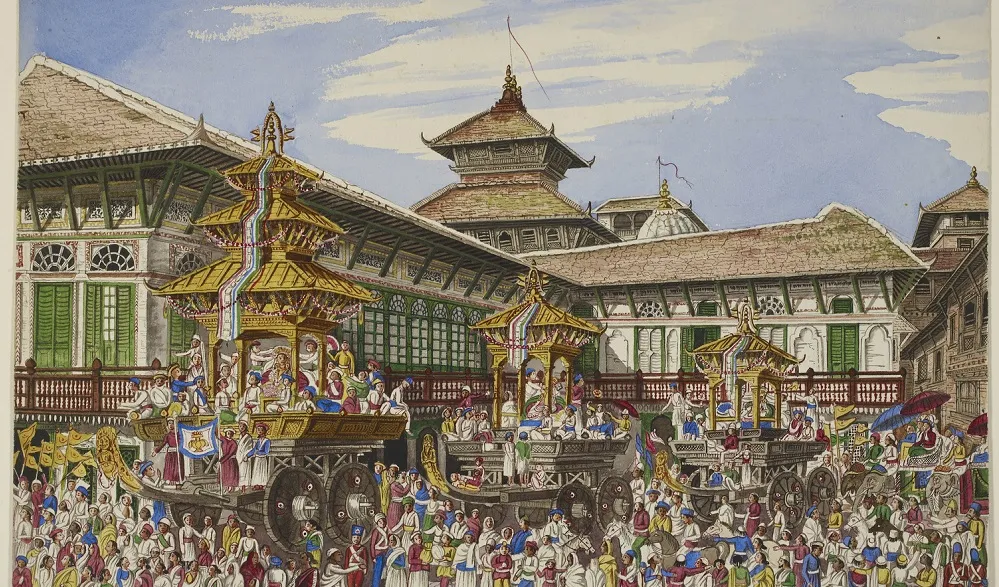Table of Contents
ToggleNepal National Museum -
In the heart of the enchanting capital city of Kathmandu, where ancient pagodas whisper tales of bygone eras, stands a repository of Nepal’s rich cultural narrative — the National Museum of Nepal. Nestled amidst the Himalayas, this museum is not merely a building; it’s a time capsule that holds within its walls the essence of a nation’s identity. As we step into this sanctuary of history, art, and heritage, we embark on a journey through time, traversing the diverse landscapes of Nepal’s past. Each artifact and exhibit is a thread in the vast tapestry of Nepal’s captivating story. Join us as we unravel the mysteries, legends, and traditions that make up the fascinating fabric of the National Museum of Nepal.
National Museum of Nepal Location
The National Museum of Nepal is located in the center of Kathmandu, near the Hanuman Dhoka Palace. It is at Museum Road, Kathmandu 44600, Nepal.
History of the National Museum of Nepal
The National Museum of Nepal was founded in 1920 by King Tribhuvan Bir Bikram Shah Dev. It is the oldest museum in Nepal and is located in Kathmandu.
The museum was originally housed in the Hanuman Dhoka Palace, but it was moved to its current location in 1979. The new building was designed by the architect Janak Raj Joshi and was built in the traditional Newari style.
The museum’s collection includes over 100,000 artifacts. These artifacts represent the art and culture of Nepal from prehistoric times to the present day. The collection includes sculptures, paintings, textiles, weapons, and other objects.
The museum is divided into several galleries, each of which is dedicated to a different period or aspect of Nepal’s history and culture. The galleries include:
- The Prehistory Gallery: This gallery displays artifacts from Nepal’s earliest inhabitants, dating back to the Stone Age.
- The Early Historic Gallery: This gallery displays artifacts from the Licchavi and Gupta periods, dating from the 4th to the 7th centuries CE.
- The Medieval Gallery: This gallery displays artifacts from the Malla and Shah periods, dating from the 12th to the 19th centuries CE.
- The Modern Gallery: This gallery displays artifacts from the 20th and 21st centuries.
- The Ethnology Gallery: This gallery displays artifacts from Nepal’s different ethnic groups.
- The Natural History Gallery: This gallery displays artifacts from Nepal’s natural history, including fossils, minerals, and animals
A Glimpse into the National Museum's Collections
Here are some of the highlights of the National Museum of Nepal’s collections:
- Stone Chariot: This chariot is made of sandstone and is believed to date back to the 5th century CE. It is a masterpiece of Newari art and architecture.
- Bronze Buddhas: These Buddhas are made of bronze and are believed to date back to the 8th century CE. They are some of the finest examples of Buddhist sculpture in Nepal.
- Textiles: The National Museum of Nepal has a collection of over 1,000 textiles. These textiles represent the rich textile traditions of Nepal.
- Weapons: The National Museum of Nepal has a collection of over 1,000 weapons. These weapons represent the military history of Nepal.
- Thangkas: Thangkas are painted scrolls that depict Buddhist deities and scenes. The National Museum of Nepal has a collection of over 1,000 thangkas.
- Masks: Masks are used in traditional Nepali dances and performances. The National Museum of Nepal has a collection of over 1,000 masks.
- Musical instruments: The National Museum of Nepal has a collection of over 1,000 musical instruments. These instruments represent the rich musical traditions of Nepal.
- Fossils: The National Museum of Nepal has a collection of fossils that date back millions of years. These fossils provide a glimpse into the history of Nepal’s natural world.
- Minerals: The National Museum of Nepal has a collection of minerals that are found in Nepal. These minerals are used in a variety of ways, including jewelry making and construction.
- Animals: The National Museum of Nepal has a collection of animals that are found in Nepal. These animals are preserved in taxidermy or in dioramas.
These are just a few of the many highlights of the National Museum of Nepal. It is a truly amazing place to learn about the art, culture, and history of Nepal.
Cultural Galleries at the National Museum
Here are some of the cultural galleries at the National Museum of Nepal:
- Buddhist Art Gallery: This gallery displays a wide variety of Buddhist art, including sculptures, paintings, and thangkas.
- Hindu Art Gallery: This gallery displays various Hindu art, including sculptures, paintings, and jewelry.
- Ethnology Gallery: This gallery displays artifacts from Nepal’s different ethnic groups, such as the Newars, Gurungs, and Magars.
- Natural History Gallery: This gallery displays artifacts from Nepal’s natural history, such as fossils, minerals, and animals.
- Arms and Armor Gallery: This gallery displays a collection of weapons and armor, including swords, spears, and shields.
- Musical Instruments Gallery: This gallery displays a collection of musical instruments, such as drums, flutes, and stringed instruments.
- Thangka Painting Gallery: This gallery displays a collection of thangkas, painted scrolls depicting Buddhist deities and scenes.
- Coin Gallery: This gallery displays a collection of coins from Nepal’s history, dating back to the 7th century CE
- Textile Gallery: This gallery displays a collection of textiles from Nepal, including saris, ponchos, and carpets.

Events and Exhibitions at the National Museum
The National Museum of Nepal hosts various events and exhibitions throughout the year. These events and exhibitions are a great way to learn more about Nepal’s art, culture, and history.
Some of the events and exhibitions that the National Museum of Nepal hosts include:
- Temporary exhibitions: The museum often hosts temporary exhibitions that showcase different aspects of Nepal’s art, culture, and history. These exhibitions can be on various topics, such as Buddhist art, Hindu art, or Nepal’s natural history.
- Special events: The museum hosts special events, such as lectures, workshops, and concerts. These events are a great way to learn more about Nepal and meet other people interested in the country.
- Family days: The museum also hosts family days, a great way for families to learn about Nepal together. These days often include activities such as storytelling, arts and crafts, and games.
- School visits: The museum also offers a great way for students to learn about Nepal. These visits often include a tour of the museum and a presentation by a museum educator.
To learn more about the events and exhibitions at the National Museum of Nepal, you can visit their website or social media pages.
National Museum Of Nepal Timings, Entry Fees, and Facilities
Here are the timings, entry fees, and facilities of the National Museum of Nepal:
- Timings: The museum is open from 10:30 AM to 4:30 PM, Tuesday to Sunday. It is closed on Mondays and national holidays.
- Entry fees: The entry fee for the museum is 50 NPR for citizens of SAARC nations and 150 NPR for foreigners. Children under the age of 12 are admitted free.
- Facilities: The museum has a number of facilities, including:
- A library with a collection of books on Nepal’s art, culture, and history.
- A cafe that serves snacks and drinks.
- A gift shop that sells souvenirs and books about Nepal.
- A parking lot for visitors.
Gift Shop and Souvenirs
National Museum of Nepal has a gift shop that sells a variety of souvenirs and books about Nepal. Here are some of the souvenirs that you can find in the gift shop:
- Thangkas: Thangkas are painted scrolls that depict Buddhist deities and scenes. They are a popular souvenir to buy in Nepal
- Nepali handicrafts: Nepal is known for its beautiful handicrafts, such as woodcarvings, metalwork, and textiles. You can find a variety of these handicrafts in the gift shop.
- Nepali food items: The gift shop also sells a variety of Nepali food items, such as spices, chutneys, and snacks. These make great souvenirs to take home and share with friends and family.
- Books about Nepal: The gift shop also has a good selection of books about Nepal, including history books, travel guides, and cookbooks. These are a great way to learn more about Nepal after your visit.
How to Reach the National Museum
Reaching the National Museum of Nepal, located in Chhauni, Kathmandu, is relatively easy as it’s situated in the capital city. Here’s a guide on how to reach the National Museum:
1- Taxi or Ride-Sharing Services:
- Taking a taxi or using ride-sharing services like Uber or local alternatives is a convenient and direct way to reach the museum. Most drivers will be familiar with the National Museum’s location.
2- Public Bus:
- Kathmandu has an extensive public bus network. You can take a public bus to Chhauni or the area near the National Museum. From there, it’s a short walk to the museum.
3- Microbus or Tempo:
- Microbuses and tempos (shared minivans) operate on specific routes across the city. You can find one heading towards Chhauni and get off near the National Museum.
4- Walking:
- If you’re in the vicinity or staying nearby, walking to the museum is an option. It allows you to explore the local area and enjoy the walk.
5- Bicycle or Motorcycle:
- If you’re comfortable riding a motorcycle or bicycle in Kathmandu’s traffic, you can opt for this mode of transportation to reach the museum.
6- Tour or Travel Agencies:
- Many travel agencies in Kathmandu offer guided tours that include a visit to the National Museum. You can inquire about tours that provide transportation.
7- Shuttle Services:
- Some hotels or guesthouses in Kathmandu offer shuttle services to popular attractions, including the National Museum. Check with your accommodation to see if they provide this service.
8- Local Recommendations:
- It’s always a good idea to ask locals or the staff at your accommodation for the best and most updated transportation options to reach the National Museum.
9- Check for Special Tours:
- Occasionally, there are organized city tours or heritage tours that include a visit to the National Museum. Check with tour operators for such packages.
Consider the time of day and traffic conditions when planning your trip to the National Museum. It’s also a good practice to check directions with a local or use GPS/navigation apps to ensure a smooth journey.
Final Note:
As we draw the curtains on our virtual expedition through the National Museum of Nepal, we carry with us the knowledge of a vibrant history and a deep appreciation for the rich tapestry of Nepal’s culture and heritage. This revered institution is a guardian of the past, a beacon illuminating our collective future. The artifacts within its walls echo stories of courage, creativity, and resilience, reminding us that we are part of an extraordinary journey that continues to unfold. The National Museum of Nepal isn’t just a repository of the past; it’s a testament to the enduring spirit of a nation. May it continue to inspire generations, fostering a love for our roots and a passion for preserving Nepal’s legacy.
